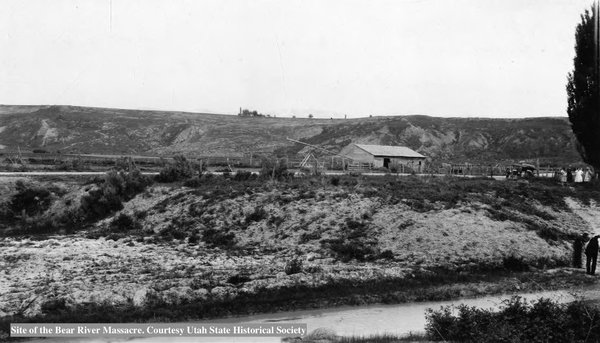Dublin Core
Title
Description
The Bear River Massacre was an event that changed the landscape of northern Utah and the fate of the Shoshone people.
In the early morning cold of January 29, 1863, between 270 and 400 Shoshone men, women, and children were killed by the U.S. Army near present-day Preston, Idaho. This was the largest number of victims in any Indian massacre west of the Mississippi, but because it happened during the Civil War, the event got little attention.
Mormon settlers began coming to Cache Valley in the late 1850s, forcing the Northwestern Shoshone people into drier areas, which could not support them. A number of Indian raids on settlers and on supply trains headed for Montana had the settlers asking the Army for help by 1862.
Colonel Patrick Edward Connor, in command of the Third California Volunteer Infantry Regiment and charged with protecting the Overland Mail Route, responded. He was convinced that Chief Bear Hunter’s band, camped on Beaver Creek, was responsible for a number of murders and stolen goods. He thus felt justified in attacking the group.
The first assault, in the early morning darkness, was a direct charge on the village. The Indians had expected some kind of attack and had prepared by digging into the river banks. They were successful in defending the village at first, but after Connor ordered some of his men to flank the camp, and after the Indians ran out of ammunition, the tide turned. Soldiers overran the village, burning lodges, and killing everyone in their path. Rape and murder of women and children followed.
Twenty-three Army soldiers were killed in the action. A few Shoshones survived, most notably Chief Sagwitch, who worked to gather the survivors and keep the community together.
The Bear River Massacre was the effective turning point in Indian-white relations in northern Utah, and resulted in the opening of more land for settlement. The Northwestern Band of Shoshone, led by Sagwitch, allied themselves with the Mormon Church and were eventually settled by the Church on land in northern Box Elder County.
Creator
Source
Image: The bank of the Bear River where Col. Connor and soldiers initiated the Bear River Massacre. Courtesy of Utah State Historical Society.
_______________
See Brigham D. Madsen, The Shoshoni Frontier and the Bear River Massacre (Salt Lake City: University of Utah Press, 1985); A.J. Simmonds, In God’s Lap: Cache Valley History as told in the newspaper columns of A.J. Simmonds (Logan, Utah: The Herald Journal, 2004).

